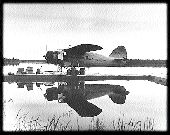I first became acquainted with bush flying in the summer of 1952 when, as a third-year geology student, I was hired by Inco as a “geological assistant” for work in northern Manitoba.
Actually, geology didn’t come into play. The job was to locate and test, on the ground, the geophysical anomalies that had been turned up by the airborne surveys during the winter. At the time, Inco was carrying out extensive exploration in the Burntwood River area, following the discovery of nickel at Mystery Lake. This, of course, would eventually prove successful with the discovery of what became the Thompson mine.
Upon arrival at Wabowden, situated on the Churchill railway, near Inco’s base camp, I and several other students were greeted by Paddy Lane, an Inco geologist.
“C’mon over to the beer parlour!” he said. “You might as well; you’re not going to get another drink for the next four months!” (Inco’s exploration camps were dry at the time.) Needless to say, we acted on his suggestion.
The procedure was that a party of four or five students was deposited by Husky floatplane on the shore of a lake as close to any anomaly as was possible. Together with canoe, tents, and the requisite geophysical gear, we were provided with aerial photographs on which the anomalies were marked. When all the anomalies reachable from that point had been located and tested, we were moved to another location.
The pilot of the single-engine Husky was Kelly Gibb. I had noticed this grey-haired fellow soon after I arrived at Wabowden. Somebody had said he was the pilot. This surprised me. In the Royal Air Force, in which I had recently put in an 11-year stint, 35 was considered old, and this man was much older than that. But as I soon discovered, Kelly knew his onions! After several trips in the Husky, it became obvious he was a skilful pilot. He flew in and out of lakes that others would have balked at.
We were glad to see Gibb when he arrived in the evening with grub and mail — but no beer, which is what we would have appreciated most. However, at other times he would show up shouting: “Get those tents down, we’re moving!” This made him unpopular, especially when he did it when we were eating our evening meal.
I never knew Gibb’s background, but I ran into him again a few years later and he was still flying that Husky. I flew with him many times but never fully appreciated his skill until I was with a lesser pilot who shall remain nameless.
He and I were returning to La Ronge, Sask., after a prospecting trip and took off from a lake in a MM-21Norseman. There was just the pilot and myself on board. We were about 300 ft. up when the engine quit and we started to plummet toward the rocky shoals and stunted trees at the edge of the lake.
Fortunately, he kept his head and didn’t attempt to turn back. He put the nose down, switched gas tanks and pumped furiously at the throttle. Our luck was in. The engine caught and we climbed out of our almost inevitable demise.
It turned out that the pilot had not performed his routine pre-flight check. If there had been a cupful less petrol in that tank, you likely wouldn’t be reading this story.
I looked at the pilot and he looked back. Not a word was spoken. We both knew it wouldn’t come much closer than that.
— The author is a consulting geologist who lives in Bovingdon, Hertfordshire, England.


Be the first to comment on "Bush flying in Manitoba"